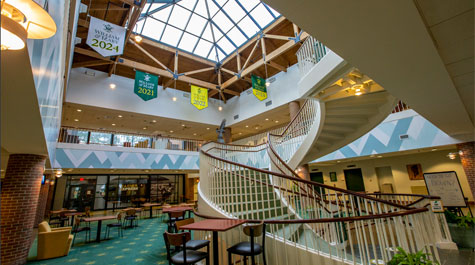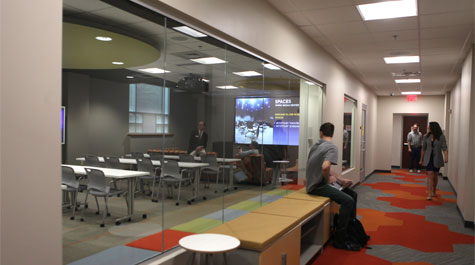W&M IT aids in effort to use data to inform campus decision-making
William & Mary Business Services & Organizational Excellence (BSOE) has teamed up with W&M Information Technology to find a way to use data-collection software to understand how our community uses campus buildings. BSOE will use this information in alignment with our Vision 2026 goals to help the university make data-informed decisions and lead with strategic intention, particularly as we think about using our capital assets effectively and meeting the university’s goals to be carbon neutral by 2030.
During the height of the pandemic, the university deployed similar capabilities that allowed students, faculty, and staff to see real-time density of popular campus spaces, such as Swem Library and dining halls. The software works with wireless access points in buildings to provide anonymized data about how, when and by how many people spaces are used.
Tim Russell, the university’s director of strategic space planning, is excited about this effort because having access to real, tangible data that tells him how often campus spaces are being used will help the university make decisions that could have big impacts on university spending, scheduling, and strategy.
According to Russell, we are using our existing campus WiFi access points, so the university didn’t have to purchase any new equipment. The team is also able to select key locations rather than covering the entire campus.
For example, Russell can look at a building like Boswell Hall and evaluate how often the classrooms are being used and by how many people. If a classroom that seats 70 people is regularly being used by a group of 10 people, we can determine if another classroom would better suit the smaller meeting.
According to Russell, outside of the university’s personnel costs, facility costs are the second largest item in the university's budget. “Helping to ensure that we're operating efficiently is important. It’s another tool in our toolkit as we work toward our shared strategic plan for Vision 2026 and our 2030 Carbon commitment.”
“This is all about being good stewards of university resources,” said Sean Hughes, associate vice president of Real Estate & Strategic Space Planning. “This helps us decide how best to operate the buildings and make informed decisions when we are trying to decide what to do with new space, as well as being comfortable that we are using our current spaces to their maximum capabilities. It helps us identify which projects are heavily used and need the most resources and it helps us configure and reconfigure spaces to better serve the students and staff within them.”
Hughes said that when they launch the project, they will begin with a pilot group that looks at specific, high-traffic buildings on campus, like the Sadler Center, Swem Library, Andrews Hall and a few others.
Privacy is our priority
The expertise of the infrastructure team in W&M IT has been essential in the beginning phases of the project. The team’s top priority is ensuring the data collected at each access point is completely anonymized, meaning when it gets pushed to the vendor, a company called Lambent, nothing is captured except for the number of devices connected to the W&M network at each access point.
W&M IT has developed its own software that first scrambles the MAC address of the devices using each access point before sending it to Lambent, making it impossible to link it back to one individual. This ensures that all that is received by the vendor is a random string identifying a particular device in a particular location.
The data will not divulge whether it’s coming from a professor or student, their gender, their name, or even if they are on an iPhone or Android device.
"W&M IT takes data privacy very seriously,” said Norman Elton, director of infrastructure. “While working on this exciting project, we ensure that data is properly anonymized. This enables us to meet the needs of the university and protect the privacy of our users."
“We will have no information about the data itself,” said Russell. “All we will know is whether the space is being used. If the numbers come back and only half the space is being used, the question then becomes how can we reduce some of our footprint by potentially going to a hybrid schedule or finding other strategic solutions? This project will enable the university to go from having no data to back up its decisions to having the ability to confirm or deny assumptions and point us in another direction so we can make better decisions.”
“The software we are using is innovative in that it can identify if multiple devices are being used by a single person while not being able to gather any identifying information about that person,” said Hughes.
The pilot phase of the project is expected to kick off this fall.
 Skip to main content
Skip to main content


